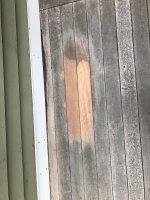HarveyWildes
Member
- Joined
- May 3, 2016
- Messages
- 941
I have a 10 year old deck with Brazilian Redwood (Massaranduba) planks. It's hard (Janka 3130), water and rot resistant due the gummy sap that dries in the wood after it is cut, so it is an ideal decking wood which I expect to last 30-50 years - probably longer than the treated joists underneath. The deck is about 400-500 ft2.
Over time the wood surface yellows and then silvers. We use the deck quite a bit, so it gets dirty as well. However, the silver color is really just skin deep - just a little sanding gets down to the original color, which ranges from a deep orange to dark red.
About 5 years ago I power washed it and treated it with a deck preservative oil with UV protection against the Colorado sun. Because of its resistance to water, some of the oil sat on the surface of the planks and hardened. Over the last 5 years the wood has silvered a bit, and dirt has embedded in the surface, especially where the oil hardened on the surface. So it was time to power wash again. This time it was much more difficult. In areas with the highest % of direct sun, the surface power washed relatively easily. In areas that were more protected, the oiled surface did not power wash well at all. I was power washing at 1500 psi. Note that power washing itself gets back to the yellow color - you only get back to the original red if you power wash and oil, or if you sand.
Question 1: Normally the recommended max psi for power washing decks is 1500 psi. Higher pressures will start to erode the wood. However, I'm not seeing any signs that the Massaranduba is eroding at 1500 psi. Would it be safer to power wash this wood at pressures higher than 1500 psi? If so, how much higher?
Question 2: How should I treat the deck going forward? I'm probably going to have to sand parts of the deck because my power washer maxes out at 1500 psi. Once I've got the surface washed and sanded, should I:
(a) Just leave it alone so I don't have to power wash through oil the next time, or
(b) Apply oil, but remove any oil that doesn't sink into the wood, or
(c) Apply oil the way I did last time and just figure that cleaning and treating my deck is a beach?
(d) Apply oil the way I did last time and just figure on sanding the deck next time?
I'd appreciate advice on any solution that will take less work five years from now.
Over time the wood surface yellows and then silvers. We use the deck quite a bit, so it gets dirty as well. However, the silver color is really just skin deep - just a little sanding gets down to the original color, which ranges from a deep orange to dark red.
About 5 years ago I power washed it and treated it with a deck preservative oil with UV protection against the Colorado sun. Because of its resistance to water, some of the oil sat on the surface of the planks and hardened. Over the last 5 years the wood has silvered a bit, and dirt has embedded in the surface, especially where the oil hardened on the surface. So it was time to power wash again. This time it was much more difficult. In areas with the highest % of direct sun, the surface power washed relatively easily. In areas that were more protected, the oiled surface did not power wash well at all. I was power washing at 1500 psi. Note that power washing itself gets back to the yellow color - you only get back to the original red if you power wash and oil, or if you sand.
Question 1: Normally the recommended max psi for power washing decks is 1500 psi. Higher pressures will start to erode the wood. However, I'm not seeing any signs that the Massaranduba is eroding at 1500 psi. Would it be safer to power wash this wood at pressures higher than 1500 psi? If so, how much higher?
Question 2: How should I treat the deck going forward? I'm probably going to have to sand parts of the deck because my power washer maxes out at 1500 psi. Once I've got the surface washed and sanded, should I:
(a) Just leave it alone so I don't have to power wash through oil the next time, or
(b) Apply oil, but remove any oil that doesn't sink into the wood, or
(c) Apply oil the way I did last time and just figure that cleaning and treating my deck is a beach?
(d) Apply oil the way I did last time and just figure on sanding the deck next time?
I'd appreciate advice on any solution that will take less work five years from now.

